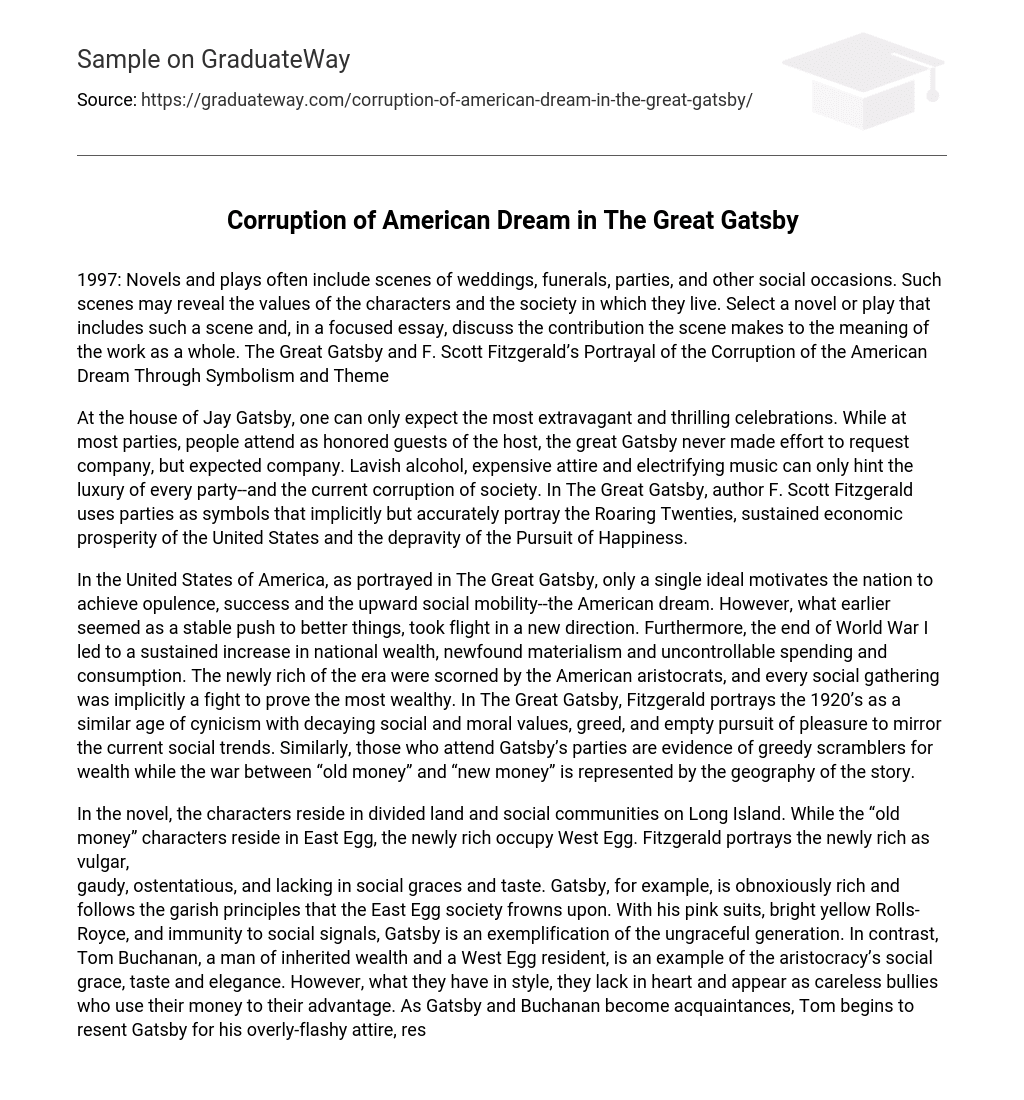1997: Novels and plays often include scenes of weddings, funerals, parties, and other social occasions. Such scenes may reveal the values of the characters and the society in which they live. Select a novel or play that includes such a scene and, in a focused essay, discuss the contribution the scene makes to the meaning of the work as a whole. The Great Gatsby and F. Scott Fitzgerald’s Portrayal of the Corruption of the American Dream Through Symbolism and Theme
At the house of Jay Gatsby, one can only expect the most extravagant and thrilling celebrations. While at most parties, people attend as honored guests of the host, the great Gatsby never made effort to request company, but expected company. Lavish alcohol, expensive attire and electrifying music can only hint the luxury of every party–and the current corruption of society. In The Great Gatsby, author F. Scott Fitzgerald uses parties as symbols that implicitly but accurately portray the Roaring Twenties, sustained economic prosperity of the United States and the depravity of the Pursuit of Happiness.
In the United States of America, as portrayed in The Great Gatsby, only a single ideal motivates the nation to achieve opulence, success and the upward social mobility–the American dream. However, what earlier seemed as a stable push to better things, took flight in a new direction. Furthermore, the end of World War I led to a sustained increase in national wealth, newfound materialism and uncontrollable spending and consumption. The newly rich of the era were scorned by the American aristocrats, and every social gathering was implicitly a fight to prove the most wealthy. In The Great Gatsby, Fitzgerald portrays the 1920’s as a similar age of cynicism with decaying social and moral values, greed, and empty pursuit of pleasure to mirror the current social trends. Similarly, those who attend Gatsby’s parties are evidence of greedy scramblers for wealth while the war between “old money” and “new money” is represented by the geography of the story.
In the novel, the characters reside in divided land and social communities on Long Island. While the “old money” characters reside in East Egg, the newly rich occupy West Egg. Fitzgerald portrays the newly rich as vulgar,
gaudy, ostentatious, and lacking in social graces and taste. Gatsby, for example, is obnoxiously rich and follows the garish principles that the East Egg society frowns upon. With his pink suits, bright yellow Rolls-Royce, and immunity to social signals, Gatsby is an exemplification of the ungraceful generation. In contrast, Tom Buchanan, a man of inherited wealth and a West Egg resident, is an example of the aristocracy’s social grace, taste and elegance. However, what they have in style, they lack in heart and appear as careless bullies who use their money to their advantage. As Gatsby and Buchanan become acquaintances, Tom begins to resent Gatsby for his overly-flashy attire, residence and lifestyle.
Despite the difference in social status, Gatsby had previously fallen in love with a young aristocratic girl named Daisy who is, ironically, Tom’s wife. To Gatsby’s advantage, in 1919, the sale of alcohol was banned, creating a business of organized crime designed to satisfy the massive demand for liquor. Thus, Jay Gatsby turned to the economics of prohibited alcohol to earn both money and respect. As a result of his fame, the parties that were meant to impress the love of Gatsby’s life epitomize not only the reckless triumph and the ultimate corruption of the American dream, but also the act that wealth plays in a judgmental society.
Through parties and enormous wealth, Gatsby was able to satisfy his infatuation with Daisy by making himself noticeable. However, Daisy returned to her husband and Gatsby was left abandoned and humiliated by Tom’s efforts. The guests who had selfishly attended his regular Saturday night parties, in the end, were none of Gatsby’s true friends. Likewise, no one had ever shown more than a superficial curiosity for his character, which exemplifies the hollowness of the supplementary American dream.
In Fitzgerald’s novel, The Great Gatsby, the corruption of the American dream is accurately portrayed through Jay Gatsby’s character. The new “American dream” is clouded with riches rather than the overall prosperity of America.Within Fitzgerald’s novel is a profound narration of the effects that materialism has on society. In summary, the members of East Egg and West Egg will never mix, and ironically, the parties that Gatsby threw to impress Daisy only seemed to drive her away. Along with his infamous background and unconventional reputation in society, it is eventually understood that Gatsby will never be seen as someone worthy of Daisy.
In The Great Gatsby, the shallow members who comprise the communities of East Egg and West Egg are emblems for the corrosive characteristic of materialism. The ethos that was once directed toward opportunities of prosperity and success is transitioned to an empty pursuit of unsatisfying wealth. Through social gathering and celebration, Fitzgerald uses symbolism to critique the current materialistic society and the effects and consequences it plays on hopes, dreams and goals.





